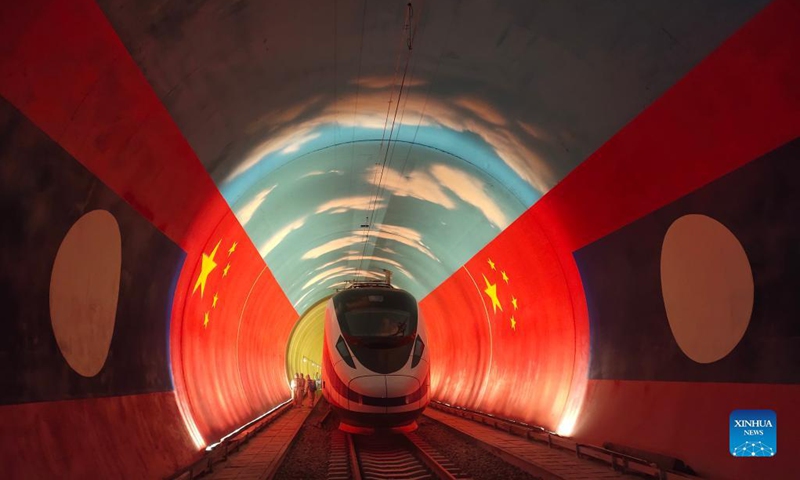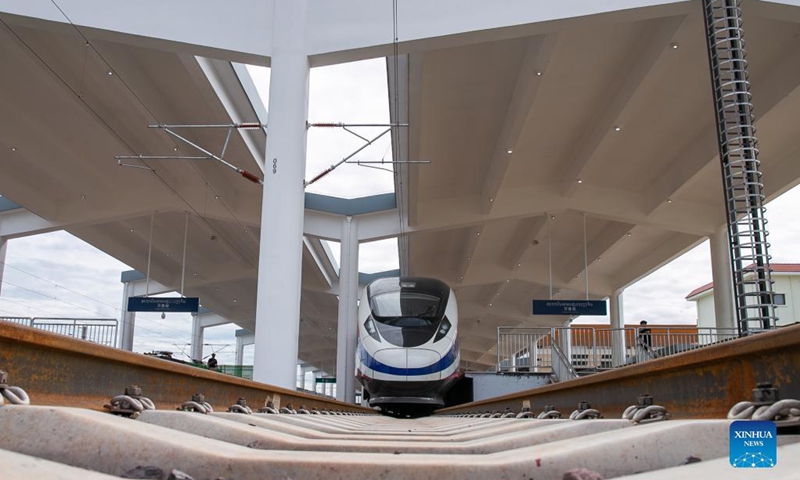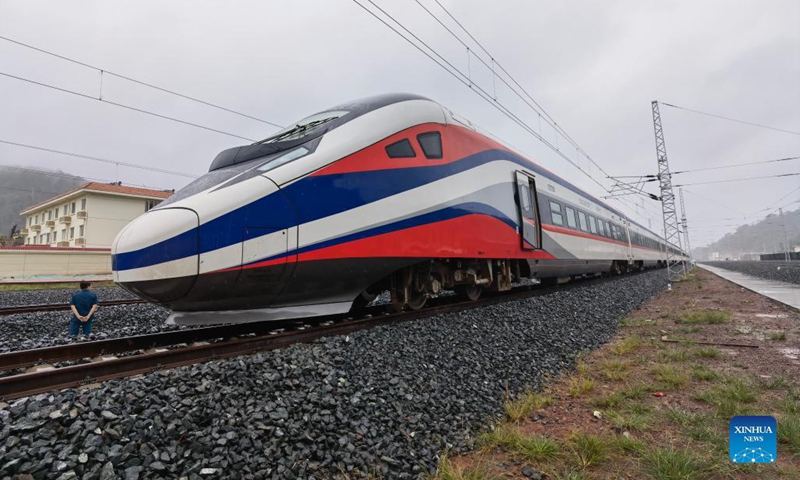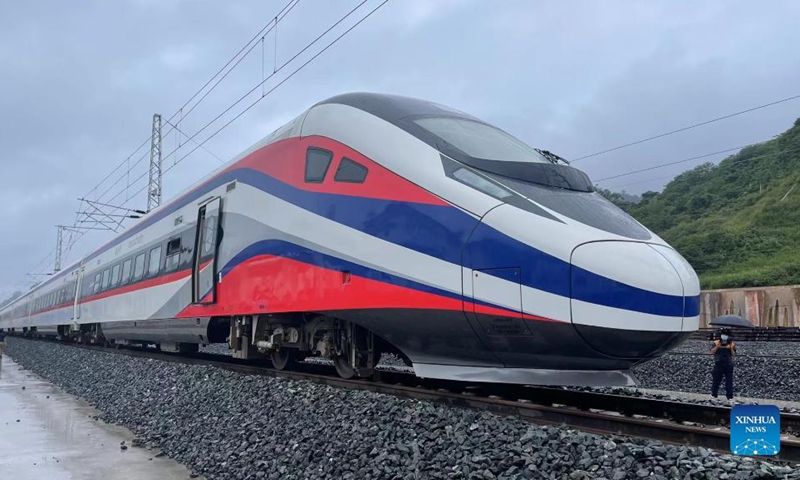
The Lane Xang EMU train passes by the China-Laos borderline inside a tunnel, Oct. 15, 2021. The streamlined "China-standard" bullet train, or electric multiple unit (EMU) train, for the China-Laos railway arrived at the newly built China-Laos Railway Vientiane Station on Saturday. (Photo: Xinhua)

The Lane Xang EMU train arrives at the China-Laos railway Vientiane station in the Lao capital Vientiane, Oct. 16, 2021. The streamlined "China-standard" bullet train, or electric multiple unit (EMU) train, for the China-Laos railway arrived at the newly built China-Laos Railway Vientiane Station on Saturday.(Photo: Xinhua)

The Lane Xang EMU train arrives at the northern Laos' border town of Boten, after passing by the China-Laos borderline, Oct. 15, 2021. The streamlined "China-standard" bullet train, or electric multiple unit (EMU) train, for the China-Laos railway arrived at the newly built China-Laos Railway Vientiane Station on Saturday.(Photo: Xinhua)

The Lane Xang EMU train arrives at the northern Laos' border town of Boten, after passing by the China-Laos borderline, Oct. 15, 2021. The streamlined "China-standard" bullet train, or electric multiple unit (EMU) train, for the China-Laos railway arrived at the newly built China-Laos Railway Vientiane Station on Saturday.(Photo: Xinhua)
The streamlined "China-standard" bullet train, or electric multiple unit (EMU) train, for the China-Laos railway arrived at the newly built China-Laos Railway Vientiane Station on Saturday.
The EMU train was officially delivered to the Laos-China Railway Co., Ltd., a joint venture based in the Lao capital Vientiane in charge of the railway's construction and operation, at a handover ceremony held in the station with the attendance of Chinese Ambassador to Laos Jiang Zaidong and Lao Minister of Public Works and Transport Viengsavath Siphandone.
The EMU, named Lane Xang, is to be put into the upcoming railway trial run. Laos was once called the Lane Xang (million elephants) Kingdom. Lane Xang, also known as Lancang, the name of the upper section of the Mekong River in China, symbolizes the China-Laos relationship as good neighbors, good friends, good comrades and good partners.
Ambassador Jiang said in his speech at the Saturday ceremony that Laos receives the first modern train in her history today is decisive progress in the construction of the China-Laos railway, and it is also a landmark achievement of the strategic docking between the China-proposed Belt and Road Initiative and Laos strategy to convert itself from a landlocked country to a land-linked hub.
"According to the current progress of construction, the Lao side proposed the coming Lao National Day (Dec. 2) as the target node to achieve official opening, and we are encouraged and willing to work with the Lao side to realize it," the Chinese ambassador said.
Jiang said that after the opening of the China-Laos Railway, the journey time from Vientiane to the China-Laos border will be shortened from two days to three hours, and that to Kunming can be just overnight, which means a leapfrog development in the connectivity between China and Laos.
Minister Viengsavath said at the ceremony that the design and manufacture of the EMU train is an important part of the building of the Laos-China railway and the Lao government attaches great importance to it. Thongloun Sisoulith, general secretary of the Lao People's Revolutionary Party Central Committee and Lao president, organized the validation of the design plan, while Lao Prime Minister Phankham Viphavanh decided the naming of the train.
The successful delivery of the Lane Xang EMU marks the beginning of the operation period of the Laos-China Railway and the conclusion of the construction period, and also announces that Laos has stepped into a new era of railway transportation, and the Lao people have ushered in a new era of transportation upgrade, said the Lao minister.
Viengsavath said, both sides will work together, after completing the construction of the Laos-China Railway, to better operate and develop the railway, to build the railway a landmark project of the bilateral friendship for the benefit of the two peoples.
The Lane Xang EMU is produced by Chinese company CRRC Corporation, with its design based on the Fuxing bullet train.
The China State Railway Group directed the design and manufacture companies to actively adapt to cross-border transport situations, fully meet the needs of the user, and make necessary improvements.
With advanced technology, the Lane Xang EMU is safe, comfortable and reliable with large passenger capacity but low operating costs, and fully meets the main performance indicators required by the China-Laos railway operation.
The Lane Xang EMU is painted in the Lao flag colors of red, blue, and white. The interior design integrates elements of traditional Chinese and Lao cultures, embodying the Lao people's vision of a better life and the friendship between the two peoples.
According to the China State Railway Group, the Lane Xang train, with the maximum operating speed of 160 km per hour, consists of nine carriages, including a locomotive, a dining coach, a first-class and six second-class coaches, and provides altogether 720 seats.
The air-conditioned carriages are spacious with comfortable seats installed with power outlets of Chinese and Lao standards. The dining coach is well equipped to meet the needs of passengers for food and leisure; the screens, broadcasts and service signs are all in three languages of Chinese, Lao, and English; and the fourth carriage with barrier-free areas is equipped with special seats, handrails, toilets, SOS call buttons and Braille guide signs to facilitate the travel of disabled passengers.
The China-Laos Railway is a docking project between the China-proposed Belt and Road Initiative and Laos' strategy to convert itself from a landlocked country to a land-linked hub.
The electrified passenger and cargo railway is built with the full application of Chinese management and technical standards. The construction of the project started in December 2016 and is scheduled to be completed and operational in December 2021.
